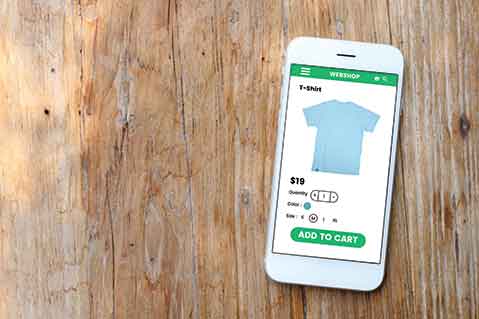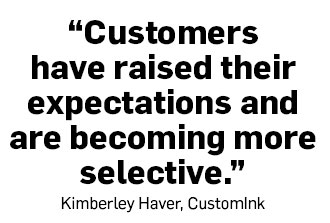Product Hub January 16, 2017
Examining Promotional T-Shirt Buying Habits
The biggest custom online T-shirt sites are raking in sales. But are they changing the shopping habits of end-buyers? Our survey digs deeper.
Gina Gorski has organized “Nickels for Nicky” events for the past seven years, ever since her son was diagnosed with mitochondrial disease. In order to spread awareness about the energy-draining disorder and raise money to help find a cure, the Philadelphia native set up $1 hot dog dinners and walkathons while brainstorming T-shirt ideas for participants.

“It was a cute little fundraiser idea,” Gorski says. “I went with ‘Nickels for Nicky’ because it sounds like we’re not asking for a ton of money, but it has definitely added up.”
Browsing for the best options on the internet, Gorski discovered that the United Mitochondrial Disease Foundation (UMDF) had an online store for promotional products managed by the Accurate Advertising Specialty Company, a distributor and screen printer in Pittsburgh. She spoke with a representative over the phone and shared her vision for the shirts: lime green in honor of mitochondrial disease awareness with a less formal, more playful black font, and Nicky’s dimply, smiling face.
Accurate Advertising implemented Gorski’s vision and quickly sent her a proof, which she loved. Gorski ordered 150 shirts at first, and then every couple of years, she ordered anywhere from 25 to 50 more. Each shirt costs $7.25 to manufacture, and she sells them for $10 each.
“Nick wants to update the shirt, but everybody knows that little face,” Gorski says. “He hates it, but we love it.”
In today’s e-commerce, self-service landscape, Gorski’s story feels like an anachronism. Who needs phone calls when hundreds of online T-shirt sites offer the capability to design, order and purchase in just a few clicks?

But as exclusive ASI survey data shows, the traditional model of ordering promotional T-shirts has not died out. In fact, the old and new ways are nearly even. ASI found that while 49% of end-buyers have used an online company that directly supplies T-shirts, 48% said they work with a promotional product distributor/expert that handles all of the logistics.
“Customers rely on us to take care of them,” says Wendy Ferber, owner of Pride Products Distributors LLC (asi/299307). “You wouldn’t hire a distributor to do this work for you if it was easy.”
The Online Shift
The most high-profile custom T-shirt sites are having runaway success. Vistaprint (which a third of T-shirt buyers in our survey say they’ve purchased from) has grown into a $1.2 billion behemoth, generating 10% growth in its most recent fiscal year. CustomInk, the DIY T-shirt provider launched in 2000, has attained nearly $300 million in annual revenue, with year-over-year growth of 50%. CafePress earned $104.5 million in 2015. Five-year-old Teespring printed 7 million shirts last year.
Despite the growth of online vendors, traditional distributors maintain that their sales haven’t been impacted. “We definitely haven’t seen a decline in our business as far as losing people to online providers,” says Eric Hamlin, vice president of sales at Kotis Design (asi/244898).
It’s a matter of different business models, Hamlin says. Many online vendors target customers looking to make a one-off shirt for a Christmas gift or special occasion. Perhaps the customer wants to capitalize on a pop culture trend or viral sensation. Traditional distributors typically serve orders by the hundreds or thousands, whereas online vendors cater to individual orders or small bundles. “Vistaprint offers low quantities of T-shirts at affordable prices that many other online sellers cannot,” says Sara Nash, public relations manager for Vistaprint.

Click here for a larger image of the above infographic
A rise in digital decoration technologies – techniques like direct-to-garment printing and sublimation that require no setup fees – has enabled more distributors and decorators to operate with low minimums. But for the most part, companies that specialize in one-offs are a rarity in the promotional product industry. “Our industry was not built to be a super-efficient fulfillment type of industry,” says Mitch Emoff, executive vice president of Goldner Associates (asi/209800). “It’s very difficult to make money by producing one T-shirt.”
Low minimums are just one of the ways that online sellers have rewired the customer buying experience. “Customers have raised their expectations and are becoming more selective,” says Kimberley Haver, vice president of merchandising at CustomInk, about where T-shirt buyers choose to shop. Consumers no longer have to settle for local availability at the expense of quality work or other desired traits. “Consumers shopping online for custom decorated apparel now expect a wide selection of choices, easy and fun design experience, and superior customer care,” she adds.
Even if end-buyers don’t purchase from an online site, they use it as virtual window shopping – a way to check products and prices and tinker with designs before making the final purchase. In the survey, a third of end-buyers who purchased T-shirts in the past year visited Vistaprint but did not purchase from the site. Almost as many did the same at CustomInk (28%) and CafePress (25%).

For example, when Temple University graduate Kelly Silver was looking for T-shirts for her intramural volleyball team, she played around with different designs on CustomInk’s website before ordering from Levin Promotional Products (asi/252850), a distributor her uncle owns in Harrisburg, PA. “Online T-shirt sites have had a positive effect on the habits of consumers,” Nash says. “The willingness to shop online for apparel has grown, and online T-shirts purchases have certainly played a role in lowering consumer hesitations.”
Distributors say the internet has made consumers much more informed. Rather than starting from scratch, customers bring sketches and proofs to the table from the onset. “It’s a blessing to be able to have a lot of things at customers’ fingertips, but at the same time, you can’t overwhelm them,” says Lucas Guariglia, president and director of sales operations at Rowboat Creative (asi/313715).
Guariglia says the initial version of Rowboat Creative’s website had every design option listed for decorated apparel. The endless customization options were supposed to make the company competitive, but it ended up stressing customers. “We realized that if you limit to more trendy and popular items, that just helps people make decisions faster,” Guariglia says. “If you have only five options available, but the customer knows that you have the ability and access to more, they feel less overwhelmed.”
A Matter of Convenience
Silver enjoyed the freedom and creativity of CustomInk’s Design Lab feature, but that was just a tool for her in the buying process. “I knew I would get quality and service from Levin,” Silver says. “I wanted something with quality that was going to hold up for several washes, and I wanted something affordable, since we were all poor college students. I was willing to compromise on convenience as long as the quality and price made the extra hassle worth it.”
Anecdotally among buyers, many believe the convenience of online shopping and low minimums come at the expense of affordable prices. But our survey found no special emphasis placed on convenience among online buyers (see sidebar). Both online and traditional buyers prize price above everything else. Given 100 points to divide up three major factors, T-shirt buyers overall ranked price first (47 points), quality second (33 points) and convenience third (20 points).
The takeaway? Price is important no matter what, and online buyers are unwilling to sacrifice on quality or price for the ease of online shopping. But that doesn’t mean convenience is unimportant. CustomInk recognizes the importance of offering a user experience across all devices. “These days, it’s just as easy to design a custom T-shirt with CustomInk on a smartphone as it is on a desktop,” Haver says.
Perhaps convenience means different things to buyers. Is convenience ordering in a few clicks? Or is it having a distributor stroll into a meeting and lay out a passel of samples that clients can see, feel and try on? Is it emailing a logo to a local screen printer and dropping in the next day to see a printed sample? (CustomInk will send blank samples for a small fee to customers within a week. A printed sample is automatically sent on orders over 250 pieces or $2,500; for orders that don’t automatically qualify, a sample is available for a non-refundable fee of $75.)
“If you’re a marketing professional at a large to mid-size company, quality is really important to you,” says Ferber. “You can’t return custom products, so if the spelling is messed up or you don’t like the design, you’re in trouble.”
As much as buying habits have changed, distributors still believe in the power of relationships and the human connection. “We’ll never be that company where customers can’t get in touch with a real live person,” Emoff says. “People still want someone to send them a production sample, a virtual proof, maybe romance them a little bit and tell them other options and a case history of why something works.”
– Email: jcorrigan@asicentral.com; Twitter: @NotReady4Radio

Product Hub
Find the latest in quality products, must-know trends and fresh ideas for upcoming end-buyer campaigns.
